Mitosis: An Interactive Animation
This animation demonstrates the stages of mitosis in an animal cell. Use the control buttons along the bottom to run the complete animation. Click on any intermediate stage (for example, Anaphase), and see a representative still frame. Interphase: Cells may appear inactive during this stage, but they are quite the opposite. Prophase: During this first mitotic stage, the nucleolus fades and chromatin (replicated DNA and associated proteins) condenses into chromosomes. Prometaphase: In this stage the nuclear envelope breaks down so there is no longer a recognizable nucleus. Metaphase: Tension applied by the spindle fibers aligns all chromosomes in one plane at the center of the cell. Anaphase: Spindle fibers shorten, the kinetochores separate, and the chromatids (daughter chromosomes) are pulled apart and begin moving to the cell poles. Telophase: The daughter chromosomes arrive at the poles and the spindle fibers that have pulled them apart disappear.
Cell Division
EXPERIMENT 7: Are chemicals, mutations, and cancer linked
The Virtual Ames Test: Are chemicals, mutations, and cancer linked? A lesson in mutation and selection Life is a collection of chemicals. Thousands of different molecules are required for the cellular functions of every plant, animal, and microorganism. Many human diseases, including certain types of cancer, have been associated with long-term exposure to certain synthetic chemicals (made by people) that are used in industry and agriculture. In contrast with the popular view and the position taken by the federal regulatory agencies, some people believe we should focus on the activity of a chemical and how much of it we are exposed to, not whether it was synthesized in a factory or made by a plant, animal, or microbe. One of the areas in which this debate about chemical safety has become quite heated is in the regulation of chemicals based on their potential for causing cancer. The Ames test is based on the following theories and assumptions: Key Concept Your Challenge Key questions
"Pea Soup" - Pea Experiment
This is an interactive pea experiment where you can breed your own hybrid pea plants! You will start with two parent plants and end up with four child plants *. Pick two of those to breed together for four new children, and so on. (Note: you can breed a plant with itself.) There are two attributes passed between generations in this simulation. Pea color (green or yellow) Pea shape (round or wrinkled) Each of these attributes are 'simple traits,' that is, there is no 'grey' area of an attribute. The source code to this program is available.
Genetics
Cellular Respiration
Photosynthesis
Biodiversity
LogiCity - Introduction
Earth Observatory : Home
World of Change Satellite images showing how our world— forests, oceans, cities, even the Sun— has changed in recent decades. Read more Blue Marble Composite satellite images of the entire Earth. Earth at Night The night side of Earth twinkles with light in these composite global and regional views. Experiments Hands-on educational activities. Visible Earth A catalog of NASA images and animations of our home planet. NASA Earth Observations View, download, and analyze imagery of Earth science data. Earth Science Picture of the Day
Global Warming
Related:
Related:



